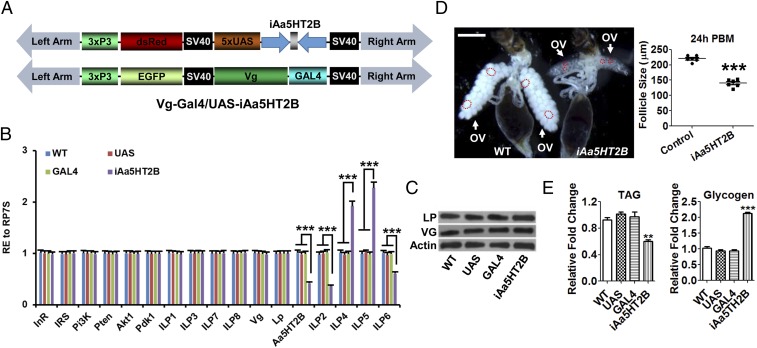Fig. 4.
Fat-body–specific RNAi to knockdown Aa5HT2B in female mosquito adults. (A) Schematic diagrams of the pBac[3xP3-DsRed, UAS-iAa5HT2B] and pBac[3xP3-EGFP, Vg-Gal4] transgenic vectors. (B) The relative expression of Aa5HT2B, ilps, insulin/IGF pathway components, Lp (Lipophorin) and Vg (Vitellogenin) in Vg-Gal4/UAS-iAa5HT2B (iAa5HT2B) and controls. iAa5HT2B displays the same trend of regulation as ΔAa5HT2B mutants in these transcripts. ilp1, -3, -4, -7, and -8 (head-specific expression) were determined in the head; Aa5HT2B and ilp6 were determined in the isolated fat-body; other genes were determined in the whole body. (C) Western blot showing the normal levels of endogenous yolk protein precursors LP and VG in a transgenic line where the Vg promoter was used to drive transgene expression. WT, UAS-responder, and GAL4-driven animals were used as control. (D) Comparison of ovaries and follicle sizes in iAa5HT2B and WT control. (Scale bar, 1 mm.) The dashed circles show the follicle shape. (E) TAG and glycogen levels in Vg-Gal4/UAS-iAa5HT2B and controls. iAa5HT2B displays the same trend of regulation as ΔAa5HT2B mutants in metabolism. Data represent three biological replicates (10 individuals in each replication for qPCR and Western blot assay; six individuals in each replication for TAG and glycogen measurement; six biological replicates with 10 individuals in each replication for follicle size measurement) with three technical replicates and are shown as mean ± SEM. **P < 0.01; ***P < 0.001.

